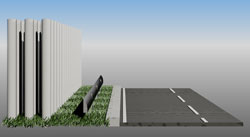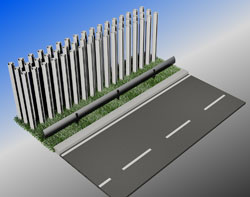Applications
Our system will be aesthetically much more pleasing than the massive solid walls currently motorways which can evoke an uncomfortable feeling of travelling in a tunnel and encourage graffiti.
 |
 |
|
| Noise barriers can be also be constructed along airports and railways. | ||
Unrestricted in design, our system could also be used to protect against coastal erosion where arrays of resonators designed to operate in the frequency range of storm waves could be placed a short distance offshore thereby reducing the waves before they reached the shore. As in the case of sound barriers, free flow of the medium (in this case water) is possible and therefore the consequent changes caused to the coastline in adjoining areas by the construction of a massive solid barrier would be alleviated.
 |
| An acoustic fence can be created from a few layers for sound proofing applications. |
A very important and beneficial property of our technology is the scalability of the effects for frequencies from the Hertz range to Megahertz range. This means that any phenomenon appearing in our technology for a certain range of frequencies and a given wavelength scale can basically be extrapolated to other systems that are scaled up or down with respect to their frequencies and wavelength scales.
Noise barrier projects in Europe have suggested that noise barriers can be integrated into the environment and have the potential to reflect current architectural trends. Recent projects have even indicated that cities competing for prestigious awards, construct aesthetic barriers at crucial entrance points to give the best possible first impression. Globally there are many emerging markets for noise barriers. Construction of noise barriers not only benefits the end user, but also benefits, acoustic specialists, architects, construction workers, manufacturers of barrier elements, contractors, installation companies and governments.
There are numerous potential engineering applications of this technology spanning many different fields, from thermal barriers, elastic/acoustic filters, vibrationless environments for high precision mechanical systems, improved transducers, waveguide, acoustic lasers, acousto-optical devices, non absorbing mirrors to sound protection devices and storm shields.
